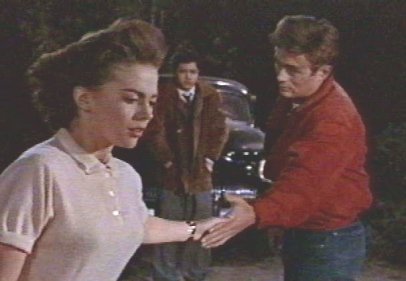 |
|
          
|
 
TIM DIRKS' PLOT ANALYSIS ON "REBEL" Rebel Without a Cause (1955) is a film that sympathetically views rebellious, American, restless, misunderstood, middle-class youth. The story provides a rich, but stylized (and partly out-dated) look at the world of the conformist mid-1950s from the perspective of the main adolescent male character. The screenplay (by Stewart Stern from an adaptation by Irving Shulman of an original storyline synopsis by director Nicholas Ray) was based on an actual case study (in Dr. Robert Lindner's 1944 factual book titled Rebel Without a Cause) of a delinquent, imprisoned teenage psychopath in the post-war years. The film was originally titled The Blind Run. The colorful wide-screen Cinemascope feature is most remembered for being the film that best presented the talent of young charismatic cult star James Dean, shortly before his premature death in 1955. It opened at the Astor Theatre in New York on October 29th, 1955, about a month after the death of its star (on September 30, 1955). It also served as a springboard for the acting careers of its two other stars Natalie Wood (in her first non-child 'adult' role) and unknown 16 year-old actor Sal Mineo. It affords a classic, semi-glamorized portrait of three troubled, frustrated, anguished, and identity-seeking teenagers - all outsiders alienated from the world and values of parents and adults. The reactionary film is considered Hollywood's best 50's film of rebellious and restless youth that spawned many other lesser teen exploitation films in its wake (another film that caused the same sensation was Marlon Brando in the earlier film The Wild One (1953)). It has been surmised that Sal Mineo's teen-aged character in the film was gay and troubled by typical problems of in-the-closet homosexuals in the 50s - the film disguises his problems, but hints at the possibility that he is seeking out Dean. [All three leading stars, who experienced troubled lives of their own, suffered death under unusual and tragic circumstances - a car crash at age 24 in 1955, a drowning at age 43 in 1981, and a stabbing at age 37 in 1976.] The film received only three Academy Awards nominations (without wins): Best Supporting Actor (Sal Mineo with the first of two unsuccessful career nominations), Best Supporting Actress (Natalie Wood with the first of three unsuccessful career nominations), and Best Motion Picture Story (Nicholas Ray). The time frame of the film's plot is set over a little more than one twenty-four hour period in status-conscious mid-50's Los Angeles, and confined to a limited number of locations. Both the beginning and ending of the film occur at nighttime (late night and early morning hours respectively) and are marked by the sound of approaching and departing police car sirens. The film ends with the fatal transference of Dean's red-jacket/windbreaker to Mineo. Befitting classic tragedy (partly inspired by Shakespeare's melodrama/tragedy Romeo and Juliet), the narrative film is neatly divided into five acts: - the exposition of the dysfunctional conflict between parents and
children - all three children are experiencing serious problems due to a
lack of a father figure |
 © 2004. All
rights reserved. Most of the materials on this site come from other websites. |
|